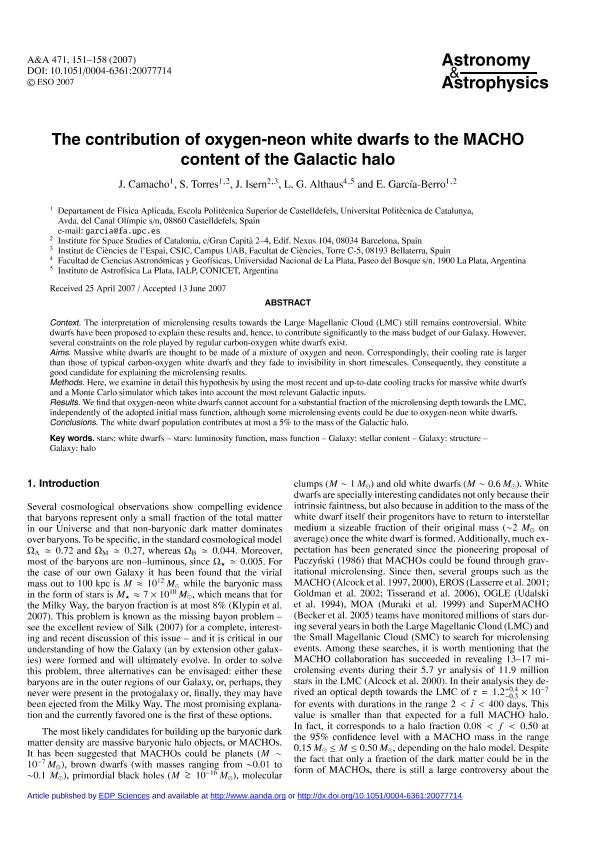Mostrar el registro sencillo del ítem
dc.contributor.author
Camacho, J.
dc.contributor.author
Torres, S.
dc.contributor.author
Isern, J.
dc.contributor.author
Althaus, Leandro Gabriel

dc.contributor.author
García Berro, Enrique

dc.date.available
2018-04-13T13:54:44Z
dc.date.issued
2007-12
dc.identifier.citation
Camacho, J.; Torres, S.; Isern, J.; Althaus, Leandro Gabriel; García Berro, Enrique; The contribution of oxygen-neon white dwarfs to the MACHO content of the Galactic halo; EDP Sciences; Astronomy and Astrophysics; 471; 1; 12-2007; 151-158
dc.identifier.issn
0004-6361
dc.identifier.uri
http://hdl.handle.net/11336/41957
dc.description.abstract
Context. The interpretation of microlensing results towards the Large Magellanic Cloud (LMC) still remains controversial. White dwarfs have been proposed to explain these results and, hence, to contribute significantly to the mass budget of our Galaxy. However, several constraints on the role played by regular carbon-oxygen white dwarfs exist. Aims. Massive white dwarfs are thought to be made of a mixture of oxygen and neon. Correspondingly, their cooling rate is larger than those of typical carbon-oxygen white dwarfs and they fade to invisibility in short timescales. Consequently, they constitute a good candidate for explaining the microlensing results. Methods. Here, we examine in detail this hypothesis by using the most recent and up-to-date cooling tracks for massive white dwarfs and a Monte Carlo simulator which takes into account the most relevant Galactic inputs. Results. We find that oxygen-neon white dwarfs cannot account for a substantial fraction of the microlensing depth towards the LMC, independently of the adopted initial mass function, although some microlensing events could be due to oxygen-neon white dwarfs. Conclusions. The white dwarf population contributes at most a 5% to the mass of the Galactic halo.
dc.format
application/pdf
dc.language.iso
eng
dc.publisher
EDP Sciences

dc.rights
info:eu-repo/semantics/openAccess
dc.rights.uri
https://creativecommons.org/licenses/by-nc-sa/2.5/ar/
dc.subject
White Dwarfs
dc.subject
Luminosity Function
dc.subject
Mass Function
dc.subject
Galaxy
dc.subject
Galaxy Halo
dc.subject.classification
Astronomía

dc.subject.classification
Ciencias Físicas

dc.subject.classification
CIENCIAS NATURALES Y EXACTAS

dc.title
The contribution of oxygen-neon white dwarfs to the MACHO content of the Galactic halo
dc.type
info:eu-repo/semantics/article
dc.type
info:ar-repo/semantics/artículo
dc.type
info:eu-repo/semantics/publishedVersion
dc.date.updated
2018-04-09T16:55:23Z
dc.journal.volume
471
dc.journal.number
1
dc.journal.pagination
151-158
dc.journal.pais
Francia

dc.description.fil
Fil: Camacho, J.. Universidad Politécnica de Catalunya; España
dc.description.fil
Fil: Torres, S.. Universidad Politécnica de Catalunya; España. Institute for Space Studies of Catalonia; España
dc.description.fil
Fil: Isern, J.. Institute for Space Studies of Catalonia; España
dc.description.fil
Fil: Althaus, Leandro Gabriel. Universidad Nacional de La Plata. Facultad de Ciencias Astronómicas y Geofísicas; Argentina. Consejo Nacional de Investigaciones Científicas y Técnicas. Centro Científico Tecnológico Conicet - La Plata. Instituto de Astrofísica La Plata. Universidad Nacional de La Plata. Facultad de Ciencias Astronómicas y Geofísicas. Instituto de Astrofísica La Plata; Argentina
dc.description.fil
Fil: García Berro, Enrique. Universidad Politécnica de Catalunya; España. Institute for Space Studies of Catalonia; España
dc.journal.title
Astronomy and Astrophysics

dc.relation.alternativeid
info:eu-repo/semantics/altIdentifier/doi/http://dx.doi.org/10.1051/0004-6361:20077714
dc.relation.alternativeid
info:eu-repo/semantics/altIdentifier/url/https://www.aanda.org/articles/aa/abs/2007/31/aa7714-07/aa7714-07.html
Archivos asociados
